Maori
The Maori people are the indigenous people of New Zealand. According to the latest data there are about 600,000 Maori people. They make 14% of total population in New Zealand. As for better climate most of Maori people live on the North Island. The Maori language or Te Reo belongs to Polynesian languages. Its alphabet has 15 letters - h, k, m, n, p, r, t, w, a, e, i, o, u, wh and ng.
There is a Maori legend saying that they arrived in Aotearoa from their homeland "Hawaiki" about 1,000 years ago. Aoteroa or "Land of the long white cloud" is the Maori name for New Zealand. Nobody is really sure where the Hawaiki is. There is an opinion claiming that Maori are actually from China. According to this theory they gradually travelled via Taiwan to the Philippines, Indonesia etc. The final stage of their migration was from Cook Island to Aotearoa (New Zealand). They arrived sometime between the 9th and 13th century AD. The first European who met Maori was the 17th century Dutch explorer Abel Tasman (1603-1659).
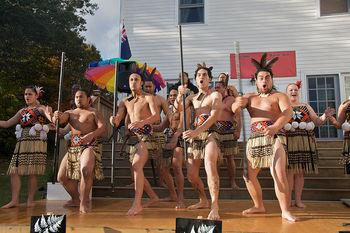 Maori dancers
Maori dancers
Before the arrival of the Pakeha (White Man) elements of Maori culture, like legends and waiata (songs), were transferred orally from generation to generation. Probably the most famous Maori tradition is the Haka dance.
The Haka dance became popular through New Zealand rugby team, better known as the All Blacks. The All Blacks Haka includes loud chanting, fierce facial expressions, agressive arm movements and foot stamping.
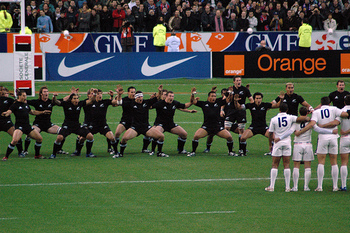 Haka dance by the All Blacks rugby team
Haka dance by the All Blacks rugby team
All Blacks usually perform the most popular Haka of all called "Ka Mate." This haka was composed by Te Rauparaha, war chief of the Ngāti Toa tribe of the North Island. It has to be said that since 2005 All Blacks sometimes perform another type of Haka which is called "Kapa o Pango." Here are the words of Haka performed by All Blacks.
Ka mate Ka mate (It is death It is death)
Ka ora Ka ora (It is life It is life)
Ka mate Ka mate (It is death It is death)
Ka ora Ka ora (It is life It is life)
Tenei Te Tangata Puhuruhuru (This is the hairy man)
Nana i tiki mai whakawhiti te ra (Who caused the sun to shine again for me)
Upane Upane (Up the ladder Up the ladder)
Upane\ Kaupane (Up to the top)
Whiti te ra (The sun shines)!
The Haka can be performed by both men and women. There are also simple versions for children. It is not only a war dance, like many people think. The Haka is danced on different occasions. It may be an arrival of someone famous or any other important event in certain community.
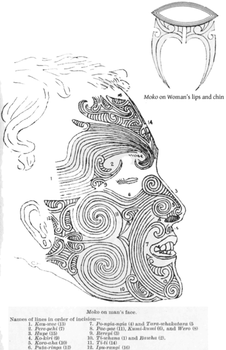 Tā moko Maori tattoo
Tā moko Maori tattoo
Tā moko is a traditional tattoo of the Maori. Men have tattoos on their faces, buttocks ("raperape"), thighs ("puhoro"), backs, stomachs and calves . Women have tattoos on their lips ("kauae"), chins, foreheads, buttocks, thighs, neck and backs.
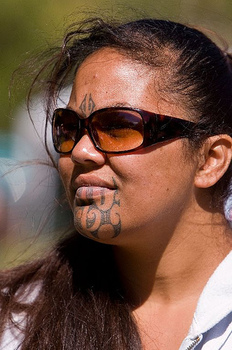 Maori woman with Tā moko tattoo
Maori woman with Tā moko tattoo
Tā moko tattoos are applied by tohunga-ta-moko (moko specialists). In traditonal Maori society they used have special, kind of sacred status. Pigments for Maori tattoo are made from "awheto" (Caterpillar fungus), "ngarehu" (burnt timbers) and the soot from burnt "kapia" (kauri gum). Pigments are traditionally applied with different "uhi" (chisels) made of albatross bone and a mallet.
Let's now move to the Maori cuisine. Traditional Maori cooking is called "hangi". First a pit is dug out. Fire is started. Stones are put it to be heated. Stones are covered with cabbage leaves or watercress to prevent the food, placed inside basket, being burned. On the basket people put Mutton cloth or something similar. Finally, some soil is put on everything. Food is ready after about three hours. Hangi is a way Maori usually prepare mutton, pork, chicken, potatoes and "kumera" (a sweet potato).
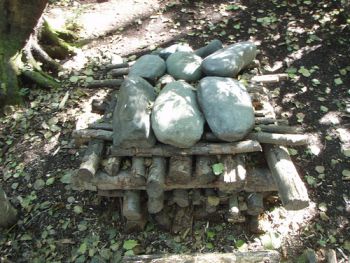 Hangi
Hangi
Hakari (feasting) was an important Maori tradition. Making a huge feast by providing food and presents for everyone attending it required lot of money. But on the other side it significantly improved social status of a family.
At Maori weddings one of groom's cousins challenges bride's father to a fight. Such a fight actually never happens. Instead the bride's father just approaches the challenger and warmly greets him.
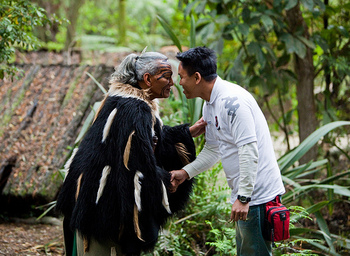 Traditional hongi greeting of the Maori
Traditional hongi greeting of the Maori
The Maori have a traditional greeting known as "hongi". It is done by pressing your nose on the nose of person you meet. There is an old Maori belief stating that during hongi the "ha" or "breath of life" is exchanged and intermingled. After hongi you are transformed from "manuhiri" (visitor) to "tangata whenua" or "one of the people of the land".
The Maori used to perform so called second burial. Dead person is put on ceremonial mats to be viewed by the family members and rest of the community. After several days body is wrapped in mats and put in a cave, a tree or buried in the ground. After one year bones of the deceased are cleaned and painted with red ochre. The bones are then moved from village to village. People mourn for the second time. After that the remains are buried in a sacred place.